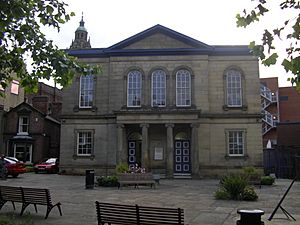Upper Chapel facts for kids
Quick facts for kids Upper Chapel |
|
|---|---|

Facade of the Upper Chapel
|
|
| Religion | |
| Affiliation | Unitarian |
| Location | |
| Location | Sheffield City Centre South Yorkshire, England |
| Architecture | |
| Architectural type | Church |
| Completed | 1700 |
| Materials | Brick |
Upper Chapel is a historic Unitarian chapel located on Norfolk Street in Sheffield City Centre, England. It is a special building because it is listed as Grade II listed, meaning it's an important historical site. The chapel is part of the General Assembly of Unitarian and Free Christian Churches, which is a group that connects Unitarian churches across Britain.
Contents
Discovering Upper Chapel
What is a Unitarian Chapel?
A Unitarian chapel is a place of worship for people who follow Unitarianism. This is a type of Christian faith that believes in one God, but it often has a more open and flexible approach to religion. Unitarians focus on personal freedom of belief, reason, and helping others.
How the Chapel Began
The story of Upper Chapel starts in the 1600s. Back then, a vicar named James Fisher worked at Sheffield Parish Church. He was forced to leave his job in 1662 because he refused to sign a new law called the Act of Uniformity 1662. This law made everyone follow the rules of the main church.
About one-tenth of his church members decided to follow him. These people were called "Dissenters" because they disagreed with the official church rules. Over time, a main group of these Dissenters formed, led by Timothy Jollie.
In 1700, Timothy Jollie's group built Upper Chapel. It was the very first non-conformist chapel in Sheffield. "Non-conformist" means it was not part of the official Church of England. The chapel was made of brick and originally faced a street called Fargate. When it first opened, about 1,000 people attended, which was a huge number – about one-sixth of Sheffield's population at the time! Parts of the original side walls are still there today.
Changes Over Time
The chapel has changed quite a bit since it was first built. In the 1840s, the building was turned around to face a different direction, looking out over fields. The roof was made taller, and the inside of the chapel was rebuilt. These changes were finished in 1848 by John Frith.
Later, more additions were made inside. You can see beautiful stained glass windows, especially nine on the ground floor that were created by an artist named Henry Holiday. Many important ministers, like George Vance Smith and Brooke Herford, led the chapel in the 1800s. One minister, John Edmondson Manning, even wrote a history book about the chapel in 1900.
Channing Hall
Upper Chapel is connected to another important building called Channing Hall. This hall faces Surrey Street and was designed by architects Flockton and Gibbs. It was completed in 1882 and has an Italianate design, which means it looks like buildings from Italy. The hall is named after William Henry Channing, who was a minister at Upper Chapel in 1875.

